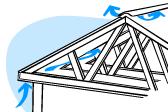
Working in conjunction with ridge vents, soffit vents can create a natural flow of ventilation in the roof cavity, which allows heat to easily escape through the top of a house.
What are soffit vents?
The underside of your home’s eaves is called the soffit. One method of cooling your roof space is to install a series of vents in the soffit.

How do soffit vents work?
Soffit vents draw cool air into the roof, straight from outside, and normally they then expel warm air through outlet vents at the top-most point of the roof through a ridge vent. Soffit vents are often present in new homes, often paired with a another ventilation system to optimise their performance.
Soffit vents are also available in two styles – continuous and individual. Continuous vents are long, narrow vents that join together to make long runs of vents. Individual vents consist of individual pieces located at various places around you roof line. For the most part, soffit vents are suitable in all properties, as long as they have eaves (and therefore soffits).
How effective are soffit vents?
Soffit vents are a very popular addition in new buildings, but on their own they won’t provide adequate ventilation. As is the case with ridge vents, soffit vents work better as part of a hybrid system that helps to force hot air into the ceiling cavity and out the vent.
|
Advantages
|
Disadvantages
|





